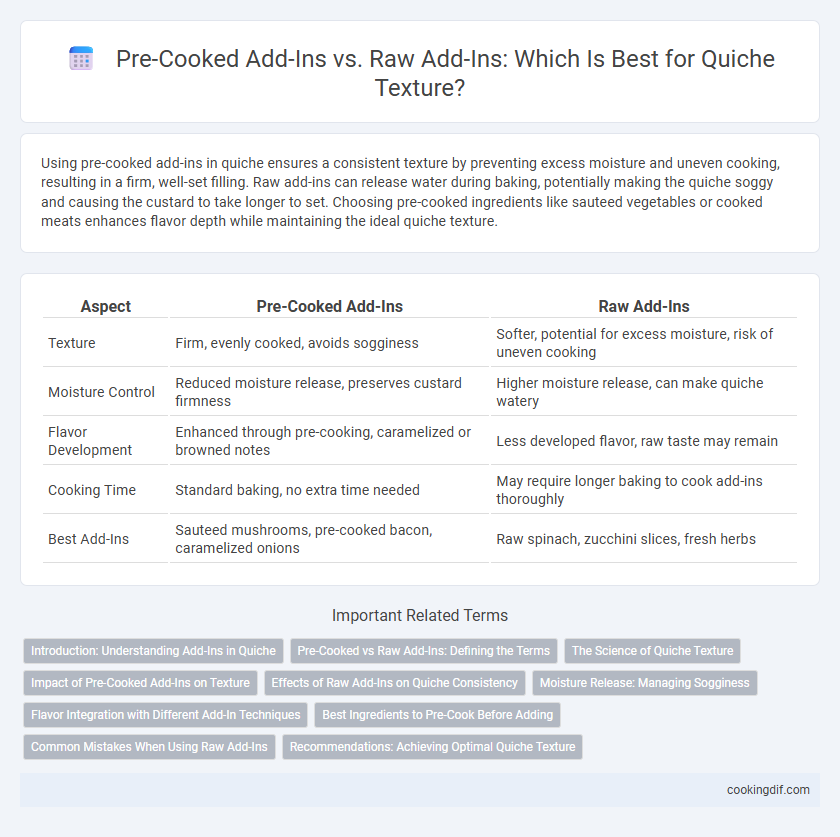Using pre-cooked add-ins in quiche ensures a consistent texture by preventing excess moisture and uneven cooking, resulting in a firm, well-set filling. Raw add-ins can release water during baking, potentially making the quiche soggy and causing the custard to take longer to set. Choosing pre-cooked ingredients like sauteed vegetables or cooked meats enhances flavor depth while maintaining the ideal quiche texture.
Table of Comparison
| Aspect | Pre-Cooked Add-Ins | Raw Add-Ins |
|---|---|---|
| Texture | Firm, evenly cooked, avoids sogginess | Softer, potential for excess moisture, risk of uneven cooking |
| Moisture Control | Reduced moisture release, preserves custard firmness | Higher moisture release, can make quiche watery |
| Flavor Development | Enhanced through pre-cooking, caramelized or browned notes | Less developed flavor, raw taste may remain |
| Cooking Time | Standard baking, no extra time needed | May require longer baking to cook add-ins thoroughly |
| Best Add-Ins | Sauteed mushrooms, pre-cooked bacon, caramelized onions | Raw spinach, zucchini slices, fresh herbs |
Introduction: Understanding Add-Ins in Quiche
Pre-cooked add-ins, such as sauteed vegetables or browned meats, enhance quiche texture by reducing moisture release and preventing a soggy crust. Raw add-ins like fresh spinach or uncooked onions may introduce excess water, leading to a less firm filling and potential texture imbalance. Selecting the right preparation method for add-ins optimizes the quiche's overall structure and mouthfeel.
Pre-Cooked vs Raw Add-Ins: Defining the Terms
Pre-cooked add-ins in quiche, such as sauteed vegetables or fully cooked meats, contribute a consistent texture and prevent excess moisture release during baking, ensuring a firmer crust. Raw add-ins like fresh spinach or uncooked bacon release more water and require longer baking to cook through, potentially resulting in a soggier texture. Understanding pre-cooked versus raw add-ins optimizes quiche texture by balancing moisture content and cooking times for a perfectly set filling.
The Science of Quiche Texture
Pre-cooked add-ins such as sauteed vegetables and browned meats release less moisture during baking, preserving a tender, flaky crust and a firm, custard-like filling in quiche. Raw add-ins tend to release water as they cook, potentially creating a soggy texture due to the excess moisture affecting the egg custard's set. Understanding the water content and cooking stages of ingredients is crucial to achieving the ideal balance between a creamy filling and a crisp pastry shell in quiche.
Impact of Pre-Cooked Add-Ins on Texture
Pre-cooked add-ins in quiche, such as sauteed vegetables or seared meats, release less moisture during baking, resulting in a firmer and more consistent custard texture. Raw add-ins tend to release water as they cook, sometimes causing the quiche filling to become watery or unevenly set. Using pre-cooked ingredients ensures a balanced texture by minimizing excess liquid and enhancing the overall structural integrity of the quiche.
Effects of Raw Add-Ins on Quiche Consistency
Raw add-ins in quiche, such as uncooked vegetables or meats, release moisture during baking, often leading to a softer, sometimes soggy texture that can affect the overall consistency. The water content from raw ingredients can dilute the egg custard, resulting in a less firm and more watery filling. Pre-cooking these add-ins helps control moisture levels, ensuring a denser, more structured quiche texture.
Moisture Release: Managing Sogginess
Using pre-cooked add-ins in quiche minimizes moisture release during baking, preventing a soggy crust by reducing excess water content. Raw add-ins tend to release more liquid, which can seep into the pastry and compromise its crispness. Properly draining or sauteing vegetables like spinach or mushrooms before adding them to the quiche helps maintain optimal texture and structural integrity.
Flavor Integration with Different Add-In Techniques
Pre-cooked add-ins in quiche enhance flavor integration by allowing ingredients like sauteed vegetables or browned meats to release concentrated aromas and develop deeper savory notes before baking. Raw add-ins, such as fresh spinach or unseasoned diced vegetables, retain a crisper texture and fresher taste, but may release excess moisture during baking, potentially softening the quiche crust. Choosing between pre-cooked or raw add-ins depends on desired texture balance and the intensity of flavor infusion in the final dish.
Best Ingredients to Pre-Cook Before Adding
Pre-cooking ingredients like onions, mushrooms, and bacon enhances quiche texture by releasing moisture and concentrating flavors, preventing soggy crusts and uneven cooking. Raw vegetables such as spinach and bell peppers require minimal cooking but benefit from slight sauteing to reduce water content and improve tenderness. Meats like ham or cooked chicken can be added directly, while seafood typically needs pre-cooking to maintain optimal texture and safety in the quiche filling.
Common Mistakes When Using Raw Add-Ins
Using raw add-ins in quiche often leads to uneven texture and excess moisture, causing a soggy crust and undercooked filling. Common mistakes include neglecting to properly saute or drain vegetables like spinach, mushrooms, and onions, which release water during baking and dilute flavor concentration. To ensure a firm texture and rich taste, pre-cooked and well-drained add-ins are essential for preventing a watery quiche.
Recommendations: Achieving Optimal Quiche Texture
Pre-cooked add-ins like sauteed mushrooms, caramelized onions, or roasted vegetables release less moisture, preventing a soggy quiche crust and ensuring a firm, custardy texture. Raw add-ins such as fresh spinach or diced tomatoes increase moisture content and may require thorough draining or blanching before use to avoid a watery filling. For optimal quiche texture, balance moisture levels by selecting pre-cooked ingredients or adequately preparing raw ones to maintain a tender but structurally sound quiche.
pre-cooked add-ins vs raw add-ins for quiche texture Infographic

 cookingdif.com
cookingdif.com